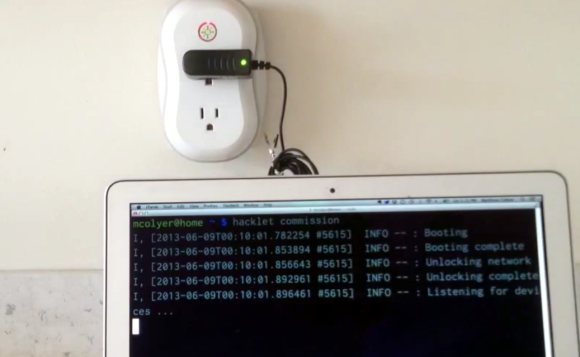
Linux users now have a simple option for controlling the Modlet smart outlet. Hacklet is a Ruby script that can switch and read status information from Modlet.
This is the first we remember hearing about Modlet. It’s another take on controlling your appliances remotely. Unlike WeMo, which puts control of one outlet on WiFi, the Modlet uses a USB dongle to control two outlets wirelessly. It has the additional benefit of reading how much current is being used by each plug. This does mean that you need a running computer with the USB dongle to control it. But cheap embedded systems like the Raspberry Pi make this less of an issue both in up-front cost, and the price to keep it running all the time.
[Matt Colyer’s] demo video includes an unboxing of the $60 starter kit. The screen seen above shows his script pairing with the outlet. It goes on to demonstrate commands to switch it, and to pull the data from the device. He even provides an example of how to use IFTTT with the script.















I have round my house a number of units branded “Status”, but made by who knows in Shenzhen somewhere. I bought them from Asda in the UK, which is now owned by Walmart. Anyway they’re mains-switching, relay-using (you hear the click) radio controlled mains outlets. You plug them between the outlet and the appliance, like a timer switch. The RF remote is a little grey thing with 8 buttons, 4 channels on and off, plus a 9th “all off”. Good for disabled people who can’t bend down to work power switches.
The point is, they’re really cheap! 5UKP for one set, 1 remote control plus 1 mains unit, or 10UKP for a pack of 3 units and 1 remote. The least one could do is bridge the switch contacts (real clicky switches, too!) in the remote, to bring MCU control. Or you could disassemble the unit, or just find the protocol and beam it yourself.
I mention them cos they’re so cheap, reliable (I’ve had them years, used all the time for my TV and PC), and probably useful. Plus no nasty mains handling for you, that’s all kept in the manufactured unit at the other end of a radio wave.
The units are “smart”, a simple button lets them learn which button, and which remote, they respond to. I presume the remotes each come with different ID codes preset, so you could run as many together as you wanted with no interference. Tho I haven’t tested that.
The problem with those units is that you have no feedback. You don’t know if they successfully responded to your command and this makes them quite useless in some cases.
Another big feature of these outlets is power consumption monitoring.
They’re easy to control from a 433MHz transmitter (eg Jeenode) too – the remote uses a HS1527 chip
Beware though, the relay is 10A, not the 15 you’d expect…
I noticed the ampage, but I’m the rare sort who actually reads what it says in the instructions. For feedback, Dean, there is an LED on the switch unit itself that signifies on / off, so there’s potential to add a light sensor and send status back, if you wanted to. If you used one to control a server’s power, the server itself could tell you when it’s switched on.
They’re not quite as capable as the IP-addressable box here, but the price really reflects that, must be lots of uses for them. Maybe added to a Raspberry Pi or suchlike and you could make something up yourself with the radio link giving the advantage of not having to run mains cable around.
WTF!? I’m talking about some different IP-based power switching box here, not the one in the article. A black one with 4 switches on it. Where’s my head at? Carry on as usual, pardon me.
I understand that, however, I would still like to see cheap 433 MHz sockets with feedback.
Hi,
Is there a way to toggle? I have a raspberry pi set up to a touchpad and wish to control the outlet via a single click. Thanks.
Thank You. I’m using Linux so this is useful for me and helpful for me too. Let me again try it.